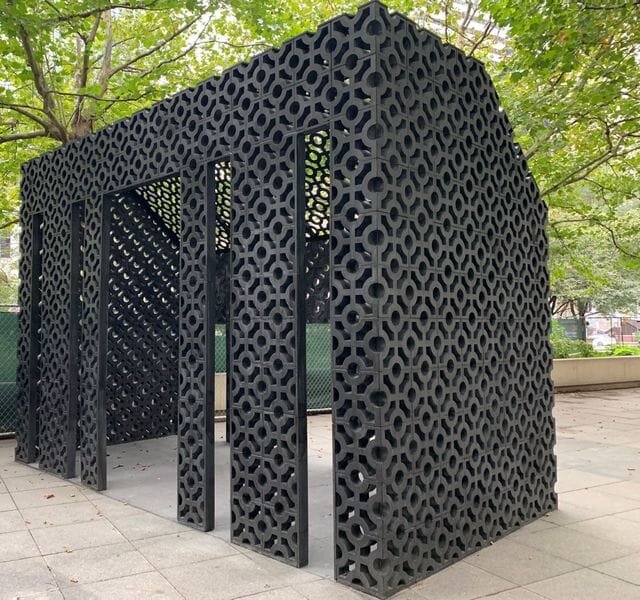![The Screenhouse, a project built from bricks made from 3D printed molds [Source: Fast Radius]](https://fabbaloo.com/wp-content/uploads/2020/05/image-asset_img_5eb08df2715dc.jpg)
This week’s selection is “Screenhouse” by Artist Edra Soto.
The project was to complete an unusual 10-foot-tall structure in Chicago’s famous Millennium Park, where there are several rather interesting architectural features on display. The structure would be a walk-through artistic display that could allow light to pass in interesting ways.
The Screenhouse was intended to be built using concrete blocks, some 400 in number. These would be cast using special Ductal concrete that could withstand the exterior exposure and provide strength for many years.
Concrete Casting Problems
However, the contractor assigned to produce the concrete blocks was having severe challenges in doing so due to the geometry of the blocks.
To cast the concrete, molds must be made, and the contractor, Navillus Woodworks, attempted to produce them using CNC milled Corian material.
This proved ineffective, as the Corian was too heavy and they could not properly produce the center support area. They turned to 3D printing technology from 3D print service bureau Fast Radius, who happen to operate HP industrial 3D printers.
HP Nylon Casting
![3D design for a concrete casting mold [Source: Fast Radius]](https://fabbaloo.com/wp-content/uploads/2020/05/image-asset_img_5eb08df2b3e67.jpg)
Fast Radius were able to design a mold that could successfully be 3D printed on HP equipment. For this print they chose nylon PA-12.
This is quite an interesting challenge, as casting concrete is problematic: it’s very heavy, it introduces significant heat while curing, and requires near-watertight smooth surfaces. Many common 3D print materials would not be able to withstand the repeated casting process, and misinformed casts due to warping molds would have been a failure.
Fast Radius Production
![3D printed concrete casting mold for the Screenhouse [Source: Fast Radius]](https://fabbaloo.com/wp-content/uploads/2020/05/image-asset_img_5eb08df2f3c34.jpg)
Fast Radius was able to design a sparse-filled mold design that was able to withstand multiple concrete casts in PA-12. They explain:
“With HP MJF technology, Navillus and Fast Radius printed and tested three design iterations in a matter of only ten weeks before settling on the final design. And because MJF parts are suitable for end-use, Navillus tried out the prototypes in the context of the rest of the mold. The team settled on a design that was thin, lightweight, and suited to concrete casting.”
And:
“Fast Radius ultimately produced nine PA 12 parts for each block mold and supplied Navillus with 21 sets of parts. It took three months from the moment Navillus met Fast Radius until they had parts in hand.”
Thus Navillus was able to produce the 400 required concrete blocks and properly assemble the Screenhouse display.
Freedom To Design
![Brick detail on the 3D print-assisted Screenhouse [Source: Fast Radius]](https://fabbaloo.com/wp-content/uploads/2020/05/image-asset_img_5eb08df3ad642.jpg)
What I find interesting about this process is that it’s another instance where a traditional technology can be made better using 3D printing technology.
Casting is a centuries-old process, yet it was unable to easily produce these blocks. With 3D printing, it was possible.
Why did this happen? I think it’s because the artist in this case envisioned a design that might have been “impossible” to produce years ago. But today with 3D printing the constraints of design are significantly loosened, and thus artists can broaden their imagination when conceiving possible structures.
That’s the way the world should be: make a design, whatever it might be, without regard to the constraints of the past.
Via Fast Radius

